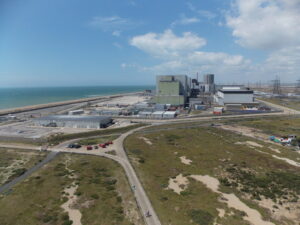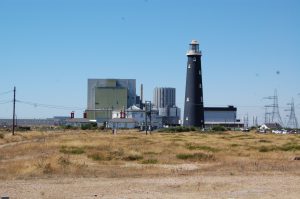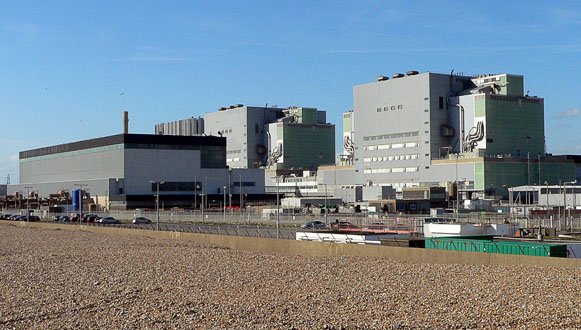Plans to bring nuclear power back to Dungeness have moved a step closer after two local councils revealed plans to press the government to include the Romney Marsh site in a list of possible power stations. Documents for the cabinet meeting of Folkestone and Hythe District Council on April 20 show discussions have already begun with Rolls Royce who make Small Modular Reactors and EDF who provide Advanced Modular Reactors.
Along with Kent County Council, FHDC has also been talking to Natural England and the Nuclear Industry Authority. The papers say the councils are “bringing forward a proposition for Dungeness to generate power as quickly as possible”. It comes after chancellor Jeremy Hunt announced the “Great British Nuclear” scheme last month – reclassifying nuclear power as “environmentally sustainable”, reducing the costs of generating it to produce 25% of the UK’s electricity by 2050.
The two power stations at Dungeness no longer make any electricity. Dungeness A stopped producing power in 2006, was defuelled in 2012, and demolition of parts of the building began in 2015. Dungeness B is currently being defuelled after technical issues were discovered by the current owners EDF in 2021.

The report adds the councils will aim to “set some high-level criteria around site use, scale and potential for the site”. The councils will then have to establish test criteria around “environmental restrictions; phasing of new nuclear on site alongside decommissioning activity; community engagement and support; economic impact and commercial viability internally and with a range of partners”.
FHDC leader David Monk (Con) described the scheme as “absolutely exciting. The power station is an economic driver for the district. So the idea is to encourage the government to allow some small modular reactors to be fitted on one of the sites. Overall, the Romney Marsh is very nuclear tolerant. After all, a whole load of them helped build the place and a whole load of them work there. If there’s competition for these power stations up and down the country, then we want to be at the forefront of it.”
However, others on FHDC don’t agree. Cabinet member Lesley Whybrow (Green) said: “My big worry with it is what happens with the nuclear waste afterwards. Because it’s radioactive for tens of thousands of years it really needs to be stored deep underground.”

Small Modular Reactors (SMRs) are a proposed class of fission reactors, which are physically smaller and faster to construct than conventional nuclear reactors. Rolls Royce began work on a SMR design in 2015, and the company says it “expects to receive UK regulatory approval” for the design by mid-2024, and wants to roll out the 470-megawatt atomic generators for use in the UK’s energy system.
Cllr Whybrow added: “Even a small modular reactor is going to take a while to build and a lot of money to build, my view is that while you’re doing that you could be providing renewable energy, you could be providing green jobs for retrofitting houses. I think it’s pretty unlikely that we’ll end up with one and I think it’s just raising false hopes really.”
Image Credits: John Webber Creative Commons , Chris Downer https://www.geograph.org.uk/photo/4558095 Creative Commons .




I thought the Dungeness site had been rejected due to the once-in-a-few-hundred-years threat of a tidal wave (tsunami), combined with rising sea levels and environmental factors?
https://en.wikipedia.org/wiki/Dungeness_nuclear_power_stations
Agree with Cllr Mier – its only a few years since Fukishima power plant was devastated by a Tsunami ( if thats the correct spelling) . The decommissioning costs after around 30 years are enormous and no solution has yet been found to how to store the radioactive waste for several hundred or longer years . The German State has removed all Nuclear power generation as a result of dangers . In my view we should be super insulate as many homes as possible OR provide a bigger subsidy for ground pump heating and the Government should not just talk about it but provide long term interst free loans / grants . We have the oldest housing stock in Northern Europe and so the vast majority of homes are energy inefficient. Of course historic towns like Rye and Winchelsea wont be able to be retrofitted with proper insulation but 80 % of our housing stock can be
To recommission a nuclear power station on a rapidly shifting gravel headland which is only a few feet above current mean sea level at a time of accelerating climate emergency when in this location it is inevitable that sea levels must rise and this whole area will be totally inundated by the sea, is simply folly of the highest magnitude and incomprehensible in the extreme. An imagined “economical” benefit of a cost efficient refit to an existing facility might be seen by some as ‘better’ than any disastrous long term consequence of it being submerged under a rising sea. But let’s all wake up to the fact that we have run out of time with such short term fixes in our accelerating climate crisis. Wind turbines work well both on land and sea so let’s build here instead a forest of resilient wind turbines to be first placed on the land but capable of eventual adaptation in use to become off-shore when this area inevitably floods.
You are right Andrew in so far that Dungeness B has a shingle bund in front of the station reaching nine metres in height to protect from a ‘tsunami’. The site is on a shingle island around six metres above sea level (O.D.), the average height across the marsh is around three metres. The main reason I believe that a major new development was turned down in 2008 was due to the wildlife protections on the marsh. SMR’s don’t in my opinion have the same impact to the environment. The Folkestone to Cliff End sea defences since agreed in 2000, the last major component ‘The Rother Tidal Walls East’ development has already started. It is my opinion that the £250 million pounds spent by the EA to protect the Marsh from flooding, is due largely to the fact that the Marsh had Nuclear stations to defend.
The tsunami threat seems highly unlikely, but sea level is rising fast as meltwater flows from the Greenland ice sheet, ice sheets in Antartica and from glaciers worldwide. Given this, it would be foolhardy to construct a new nuclear power station at Dungeness, a shingle headland only a few meters above sea level. The issue of nuclear waste disposal would remain if another reactor was built, even an SMR, and there’s also the risk of accidents — such as the worrying fire at Dungeness B in 2009. EDF wanted to extend Dungeness B’s operation to 2028, way beyond its original operating lifetime, but was prevented by serious ‘technical issues’. My personal view is that it would be far more cheaper and environmentally sustainable to install wind farms and/or solar arrays on Romney Marsh — a large, sparsely inhabited area. We may have to wait a while for nuclear fusion power, but when it arrives, it’ll be a game-changer. Dungeness B, when operational, employed about 550 staff, sourced from the whole of the UK and overseas. Local people were employed, but I wouldn’t describe the facility as being essential to the local economy. Indeed, many people in the area would prefer not to have a nuclear power station on their doorstep, with the potential risk of radioactive contamination from an accident. Perhaps the KCC and FHDR should invite local people’s views via a referendum?
There seems to be a lot of experts on the technical issues of why Dungeness B power station isn’t operating!
All nuclear powers stations go through a rigorous periodic safety review of the safety case to let them operate in light of new knowledge and risk i.e. a tsunami.
Dungeness B PS has had to invest in seismic qualification of safety critical plant, building a wall to prevent the result of a tsunami and ongoing modifications.
Wind power and solar power should be part of an energy strategy which no government has ever had. Little Cheyne Court Wind Farm on Romney Marsh produces a mere 80 megawatts at full power yet Dungeness B PS did produce 1000 Megawatts at full power. Do we really want the whole of the beautiful Romney Marsh covered in wind farms and solar farms for an unreliable source of energy?
The main reason that a Dungeness C PWR, similar to Hinkley Point C and Sizewell B, was not planned for the site in the late 1980s was due to the fact that there is a spur of the Belgian geological fault close to Dungeness. I was involved with the geophysical and geotechnical tests that were carried out by the CEGB at that time to look at the feasibility of a new large nuclear power station there.